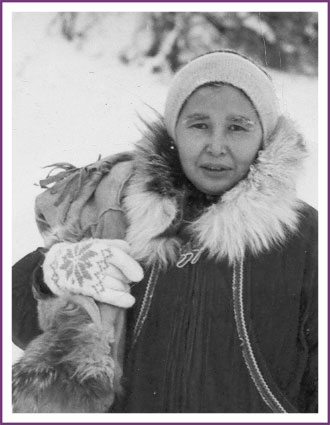ELIZA (Peter) JONES
Neełtenoyeneełno

• Preserving The Koyukon Athabascan Language
• Translator
Inducted: 2016
Koyukuk
ELIZA (Peter) JONES
Neełtenoyeneełno
Eliza Jones, born in a camp near Cutoff and raised in Huslia, devotes her life to teaching the Koyukon Athabascan language (Denaakk’e) and writing about its culture and traditions. She taught for many years at the University of Alaska Fairbanks – where she co-authored the Koyukon-Athabascan Dictionary – as a Koyukon Athabascan linguist, and, upon her retirement in 1990, she was awarded an honorary doctorate of letters.
Alaska’s Native languages have tied generations of Native people together, giving each generation a sense of identity. Western education, assimilation, and the passing of traditional Native language speakers have threatened many language dialects with extinction. Jones has taught in villages, schools, and urban community gatherings. She has written and translated stories, developed and taught curriculum, and conducted research on the language of the middle Yukon and Koyukuk rivers. Recently she has translated documents for the Tanana Chiefs Conference for their “tobacco-free” campaign; phrases for Doyon, Ltd; election ballots for the State of Alaska; Arctic Council announcements; closer to home, helped other people write traditional memorial songs for potlatches. Her willingness to share the Koyukon language has reenergized language revitalization efforts in Interior communities.
In addition to her formal work with the language, Jones served on the for-profit Gana-a’ Yoo board of directors (serving several Yukon River villages), the Ella B. Vernetti School Community Committee in Koyukuk, and Yukon River Fisheries advisory board.
Jones and her husband of 58 years, Benedict Jones Sr., make their home in Koyukuk. There and in Fairbanks, they raised nine children. In her 77 years, Eliza has humbly dedicated herself to others. Her life’s work of teaching the Koyukon language continues to inspire new generations of language learners and culture bearers. Jones quietly speaks her language and teaches the old ways demonstrating that one person can make a difference.
View Extended Bio